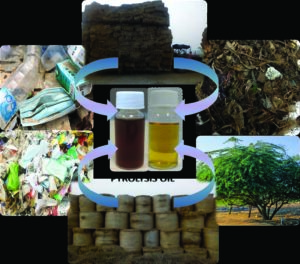CHENNAI, JUNE 15
Indian Institute of Technology Madras Researchers have developed a simple microwave process to produce bio-fuel oils with high energy values from two waste products – agricultural waste such as rice straw and bagasse and discarded plastics. This was funded by GAIL (India) Ltd.
The urgency in search of renewable fuels is driven by environmental impact of extracting fossil fuel and volatility in oil prices, associated political unrest across the world. Bio-fuel oils generated from renewable biological sources are considered a practical and pragmatic replacement for petroleum and petrochemicals.
The team was led by R. Vinu, Associate Professor, Department of Chemical Engineering, IIT Madras. The results of their work have been published recently in the reputed peer-reviewed journal Bioresource Technology and Fuel Processing Technology. The researchers who worked with Vinu in this research include Dadi Suriapparao and Banupriya Boruah.

Elaborating on this research, R. Vinu, Associate Professor, Department of Chemical Engineering, IIT Madras, said, “Biomass is the only renewable source of carbon on earth with immense potential for the production of energy, chemicals and materials with zero carbon footprint on the environment. Agricultural waste products such as rice straw, sugarcane bagasse and wood chips, among others, can potentially serve as bio-oil producing biomass.”
One of the common methods to produce bio-oil from biomass is ‘pyrolysis’ or heat-induced breakdown of the biomass components into fuel components. However, bio-oil produced by the pyrolysis of biomass contains large amounts of oxygenated groups or ‘oxygenates,’ far greater than in fossil fuels. These ‘oxygenates’ result in lower heating value of bio-oils, compared to fossil fuels, and in addition, increase their acidity and corrosiveness.
“In order to make bio-oils competitive with fossil fuels, their oxygenate content must be reduced and hydrogen content increased. Mixing biomass with hydrogen-rich materials during pyrolysis can conceivably make biomass derived bio-oil comparable to fossil-derived fuels in calorific value and chemical/physical properties,” explained Vinu.
Plastics that are rich in hydrogen, can serve as the hydrogen supplier to biomass in its conversion to low-oxygenate bio-oils. The use of plastics as a supporting material in the pyrolysis of biomass would ultimately serve two purposes – it would produce bio-oils with better properties and also help in repurposing used plastic.
The co-pyrolysis of biomass and plastics, in addition to increasing the calorific value of the fuel, also reduces char formation, thereby increasing efficiency of the process and yield of fuel. The bio-oils produced by co-pyrolysing the biomasses with the plastics had higher energy yields than those of bio-oils produced by pyrolysis of pure biomass, without the plastics.
The IIT Madras Research Team took the idea one step further and used microwave to co-pyrolyse biomass and plastics. Microwave heats materials quickly and uniformly and is a selective and energy-saving technology. They used a microwave oven to co-pyrolyse a variety of biomass including rice straw, sugarcane bagasse, groundnut shell, wood sawdust and wood from the tree called ‘Seemai Karuvelam’ in Tamil (‘Angaraji Babul’ in Hindi, scientific name Prosopis juliflora) with two synthetic plastics, polypropylene and polystyrene.
In the case of rice straw and bagasse, the team also used a zeolite catalyst to upgrade the quality of the bio-oil to light fuel oil (LFO) and heavy fuel oil (HFO). The use of catalyst resulted in better yields of the bio-oil, in addition to conferring better properties to it – the properties of bio-oil made from biomass-polypropylene mixtures were similar to that of light fuel oil and had high calorific value (43 MJ/kg), low viscosity (1 cP), optimum density (0.850 g/cc) and flash point (70 °C). This was because the oils had very little oxygenates, much like fossil-derived fuel oils. The findings of the team provide the much-needed incentive for development of such a technology that could take us closer to self-sufficiency in the energy sector.
“We believe that microwave-assisted pyrolysis process is a sustainable and energy efficient approach for resource recovery from a wide variety of wastes such as biomass agri residues, plastic wastes including disposed single-use plastics and non-reusable face masks, and a mixture of these,” Vinu adds.










